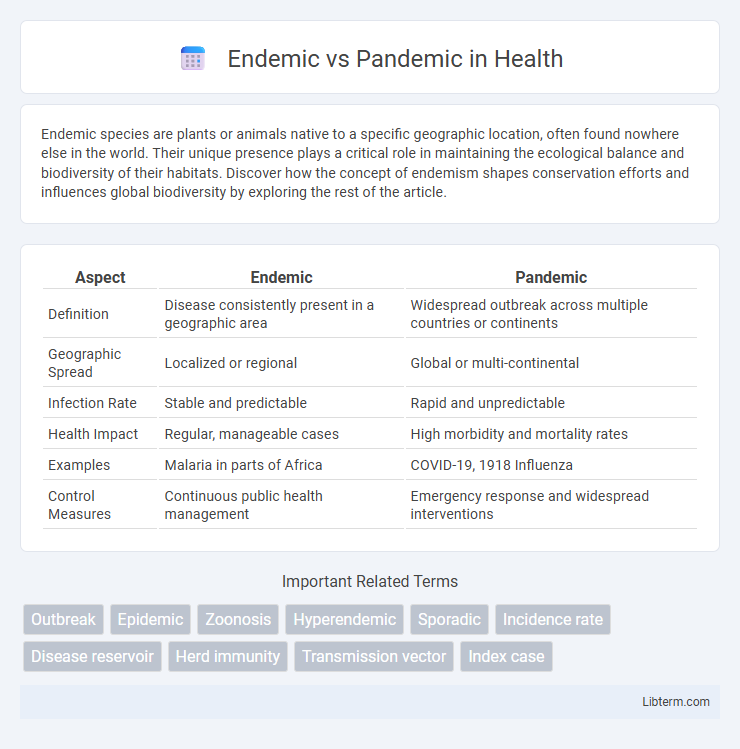Endemic species are plants or animals native to a specific geographic location, often found nowhere else in the world. Their unique presence plays a critical role in maintaining the ecological balance and biodiversity of their habitats. Discover how the concept of endemism shapes conservation efforts and influences global biodiversity by exploring the rest of the article.
Table of Comparison
| Aspect | Endemic | Pandemic |
|---|---|---|
| Definition | Disease consistently present in a geographic area | Widespread outbreak across multiple countries or continents |
| Geographic Spread | Localized or regional | Global or multi-continental |
| Infection Rate | Stable and predictable | Rapid and unpredictable |
| Health Impact | Regular, manageable cases | High morbidity and mortality rates |
| Examples | Malaria in parts of Africa | COVID-19, 1918 Influenza |
| Control Measures | Continuous public health management | Emergency response and widespread interventions |
Introduction to Endemic and Pandemic
Endemic diseases are infections that consistently occur within a specific geographic area or population at predictable rates, such as malaria in parts of Africa. Pandemic diseases, in contrast, involve widespread outbreaks crossing multiple countries or continents, exemplified by the COVID-19 pandemic. Understanding the differences between endemic and pandemic conditions is crucial for public health responses and resource allocation.
Defining Endemic: Characteristics and Examples
Endemic diseases are infections consistently present within a specific geographic area or population, maintaining a relatively stable prevalence without causing widespread outbreaks. Characteristics of endemic diseases include predictable transmission rates, localized impact, and long-term persistence, such as malaria in parts of Sub-Saharan Africa and chickenpox in many countries. Understanding endemic patterns aids public health planning by highlighting steady disease presence rather than sudden surges seen in pandemics.
Understanding Pandemic: Key Features and Impact
A pandemic involves the widespread outbreak of a contagious disease across multiple countries or continents, affecting a large population simultaneously. Key features include sustained human-to-human transmission, high infection rates, and significant disruption to public health systems, economies, and daily life. The impact of pandemics extends beyond health consequences, causing global social and economic challenges that require coordinated international response and preparedness.
Major Differences Between Endemic and Pandemic
Endemic diseases consistently occur within a specific geographic area or population at a stable rate, while pandemics represent widespread outbreaks affecting multiple countries or continents simultaneously. Endemics show predictable patterns with relatively low incidence rates, whereas pandemics involve rapid transmission, high infection rates, and often cause significant morbidity and mortality globally. Examples include malaria as an endemic disease localized to tropical regions, in contrast to the COVID-19 pandemic which spread worldwide with extensive social and economic impacts.
Causes and Triggers of Endemic Diseases
Endemic diseases persist consistently within a specific geographic area due to stable reservoirs in the environment or sustained transmission among local populations. Causes often include factors such as limited immunity within the community, continuous presence of the pathogen, and ecological conditions favoring its survival. Triggers for endemic outbreaks can involve seasonal changes, population density fluctuations, or variations in public health interventions that alter disease transmission dynamics.
Factors Leading to Pandemic Outbreaks
Pandemic outbreaks arise when infectious diseases spread rapidly across multiple countries or continents, driven by factors such as high population density, global travel, and insufficient public health infrastructure. Viral mutation and zoonotic spillover events significantly enhance transmission potential, allowing pathogens to evade immunity and infect a broader host range. Climate change and urbanization further exacerbate these risks by altering ecosystems and increasing human-animal interactions.
Public Health Strategies for Endemic Control
Public health strategies for endemic control prioritize sustained surveillance, targeted vaccination campaigns, and community education to reduce disease transmission within specific regions. Implementing localized healthcare infrastructure and continuous monitoring enables early detection of outbreaks and tailored responses that minimize endemic impact. Resource allocation focuses on prevention, treatment accessibility, and promoting behaviors that lower infection rates while maintaining long-term disease management.
Global Responses to Pandemics
Global responses to pandemics involve coordinated efforts by organizations like the World Health Organization (WHO) to implement surveillance, distribute vaccines, and enforce travel restrictions. Countries deploy public health strategies such as widespread testing, contact tracing, and social distancing measures to mitigate virus spread. International collaboration and timely information sharing enhance preparedness and response effectiveness to contain pandemics on a global scale.
Case Studies: Endemic vs Pandemic Diseases
Malaria serves as a prominent example of an endemic disease, persistently affecting populations in specific tropical regions with consistent infection rates. The 1918 influenza outbreak illustrates a pandemic, rapidly spreading worldwide and causing high mortality across diverse populations. Understanding these case studies highlights the importance of localized healthcare strategies for endemic diseases and global coordination in pandemic responses.
Future Challenges in Managing Infectious Diseases
Future challenges in managing infectious diseases include addressing the unpredictable patterns of endemic diseases that persist in specific regions, requiring sustained healthcare resources and surveillance systems. Pandemic threats demand rapid global coordination, advanced diagnostic technologies, and scalable vaccine distribution to contain outbreaks quickly. Climate change, urbanization, and increased human mobility further complicate efforts by altering disease vectors and transmission dynamics.
Endemic Infographic

 libterm.com
libterm.com